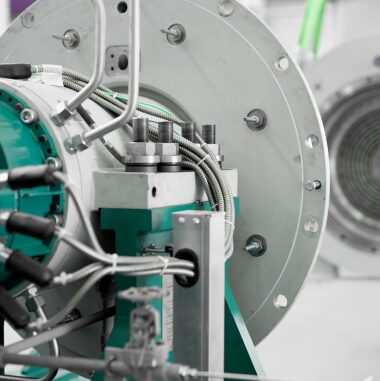- Technology
- /
- RADIAL OUTFLOW TURBINE
Exergy’s Radial Outflow Turbine
Conceptualized by Exergy the Radial Outflow Turbine (ROT) was launched in 2009, innovating the global ORC industry. It is a confirmation of Exergy’s status as a market game changer.
Exergy’s Radial Outflow Turbine technology is covered by multiple IP rights and the R&D department is always working to develop it further with new patents.

MORE EFFICIENCY AND FLEXIBILITY WITH THE ROT

ROT's key feature and differences from axial and radial inflow turbines
The ROT configuration makes it possible to convert the energy contained in the organic fluid into mechanical power with higher efficiency than the traditional axial or radial inflow turbine.
Radial Outflow Turbines divert the fluid radially through stages, simplifying blade geometry and enabling multiple stages on a single disc. The ROT is ideal for medium enthalpy geothermal and heat recovery sources.
In Radial Inflow Turbines, the fluid enters perpendicular to the rotation axis, transitioning to the axial direction as it expands within the rotor. This Configuration results in limited flow rates and complexity in achieving multistage configurations.
Axial Turbines handle fluid parallel to the rotation axis, facilitating high flow rates and are commonly used in large-scale power generation.
ROT strengths:
1
NATURAL ACCOMODATION OF WORKING FLUID EXPANSION

As it expands, the fluid encounters greater surface area, causing taller blades in the first and shorter blades in the last stages, thus facilitating a broader range of applicable fluid conditions
2
LOW SPEED TURBINE

No gearbox

High reliability

Low noise

Longer life of the bearings
3
STRAIGHT BLADES AND RADIAL DESIGN

Minimal 3D effects and turbulence
4
EASE OF MECHANICAL GROUP EXTRACTION

No fluid loss or drainage

Easy and rapid maintenance

Less tip leakage and disk friction losses

No “overhaul” maintenance on the turbine
5
SIMPLE DESIGN

Compact solution

Simple and easy construction
6
STANDARD MECHANICAL DESIGN FOR EACH TURBINE FRAME

The fluid-dynamic design of each turbine is optimized in order to reduce supply time, guaranteeing maximum efficiency without the need for mechanical redesign
7
MULTIPLE PRESSURE ADMISSIONS POSSIBLE ON A SINGLE DISK

Cost effective solution

Less limitations on cycle pressure

20% more power than a single level system with a simple configuration

Suitable for temperature heat sources as low as 90°C
8
UP TO 9 STAGES ON A SINGLE-DISK TURBINE

Better exploitation of high enthalpy resources

Extreme flexibility for changing heat source conditions, in terms of flow, temperatures and constituents

Up to 6% additional efficiency over the axial turbine

